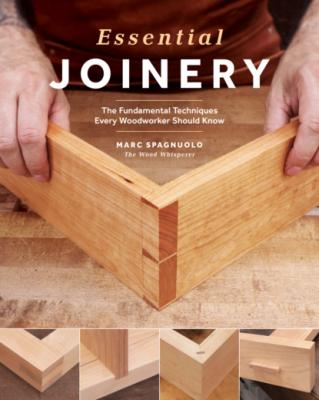ТОП просматриваемых книг сайта:
Essential Joinery. Marc Spagnuolo
Читать онлайн.Название Essential Joinery
Год выпуска 0
isbn 9781951217167
Автор произведения Marc Spagnuolo
Жанр Сделай Сам
Издательство Ingram
things has been with you ever since? Maybe
it’s because you have memories of a parent or
grandparent who was a woodworker and the
process taps into a special nostalgic corner
of your brain. For many, the reason is even
simpler: woodworking offers relief from the
stresses of everyday life.
That certainly was the case for me when I
got started back in 2004. I had an unfulfilling
job I didn’t enjoy and a very long commute. My
job as a technical service representative for
an antibody company left me unchallenged,
uninspired, and unmotivated. Woodworking
provided a glorious microcosm of new
experiences, skill sets, problems to solve, and
tangible metrics by which I could measure my
personal development. Oddly enough, the
final product of my woodworking (furniture)
wasn’t a significant motivation for me. I
actually didn’t care much for wood furniture
and my first five or six projects found homes
with family and friends.
I grew up as a city boy in New Jersey with
a mom and step dad who didn’t think it was
weird at all to fill our home with country music
and country-style furniture: red oak as far as
the eye could see, and the sounds of George
Jones streaming through the security bars
in the windows. By the time I left the nest,
I promised myself I would only fill my home
7
ESSENTIAL JOINERY
INTRODUCTION
with furniture made of metal and glass.
Apparently “cold and uninviting” was the
mood I was shooting for. It wasn’t until later in
my woodworking career that I started to get
comfortable with the idea of filling my home
with my creations. And today, I find myself in
an office trimmed with alder at a desk made
of cherry with striking sapwood accents. I
guess I should just come out and say it: I love
wood. But even though I am now fortunate
enough to be surrounded by furniture of my
own making, I still get the lion’s share of my
enjoyment from the woodworking process
itself: specifically, the crafting of fine joinery.
On the surface, joinery is just a means by
which parts are held together. But a well-
executed wood joint does much more than
that. Allow me to employ an analogy: When a
band plays, most people simply hear the song.
But to a musician, a song is heard as the sum
of its parts: guitar, bass, drums, and vocals.
When the instruments are played well and the
singer has a pleasant voice, the song will likely
sound decent. But the real magic happens
when the musicians work well together: when
the bass and drums find the pocket and create
an undeniably solid rhythm; when the guitar
melody flirts with the vocal pattern so they
become inseparable. These are the things that
separate good music from great music. So it
is with furniture. The joinery is what makes
furniture more than just a collection of parts.
It’s where the furniture comes to life and
reveals the personality, love, and pride that
went into making it.
You might think I’m a little goofy for placing
so much importance on joinery, considering
most people will never see it. But I don’t
do woodworking for pats on the back and
accolades: I do it because I love the process.
Each joint is a little project in and of itself
with its own challenges, risks, and rewards.
When I apply that final coat of finish to a newly
constructed table, I feel an incredible sense
of pride knowing I did my best and my sturdy
joints are nestled in the cozy homes I made
especially for them. Am I romanticizing joinery
too much? Perhaps. I’m trying to sell books
here! But let’s be honest, the world could
certainly benefit from a little more romance,
reverence, and yes, goofiness.
In the end, how much effort you put into
your joinery is completely up to you. There’s
nothing wrong with butt joints, biscuits, and
pocket screws. As long as you’re making
things you’re happy with, you have my full
support and respect. I do encourage all
woodworkers to explore new and improved
ways of doing things, including better joinery.
If you’re like me when I first started, you’re
probably a little intimidated by all of the
terminology and options in the world of
joinery. Classic joinery texts are informative
and exhaustive, but also overwhelming and
sometimes short on details. My goal with this
book is to demystify joinery by distilling the
topic down to the most useful joints in the
craft. I truly believe that if you can master
these five essential joinery categories, you’ll
have the skill set to make just about any piece
of furniture. We’ll cover the process in a step-
by-step fashion while showing you various
ways to get the job done. Depending on your
personal desires or tool collection, you might
prefer one method over another.
So with that long-winded introduction,
it’s time to leave the world of motivations,
intangible benefits, and country music. Let’s

